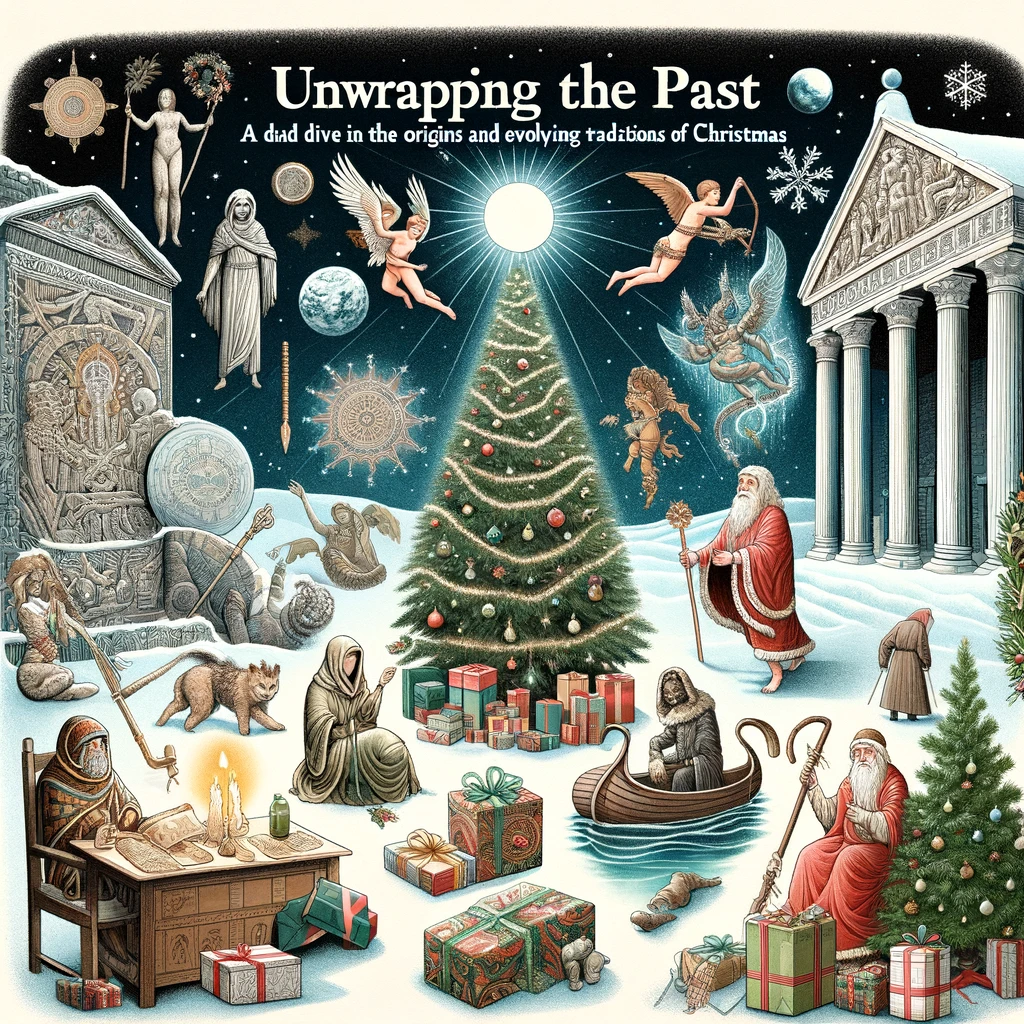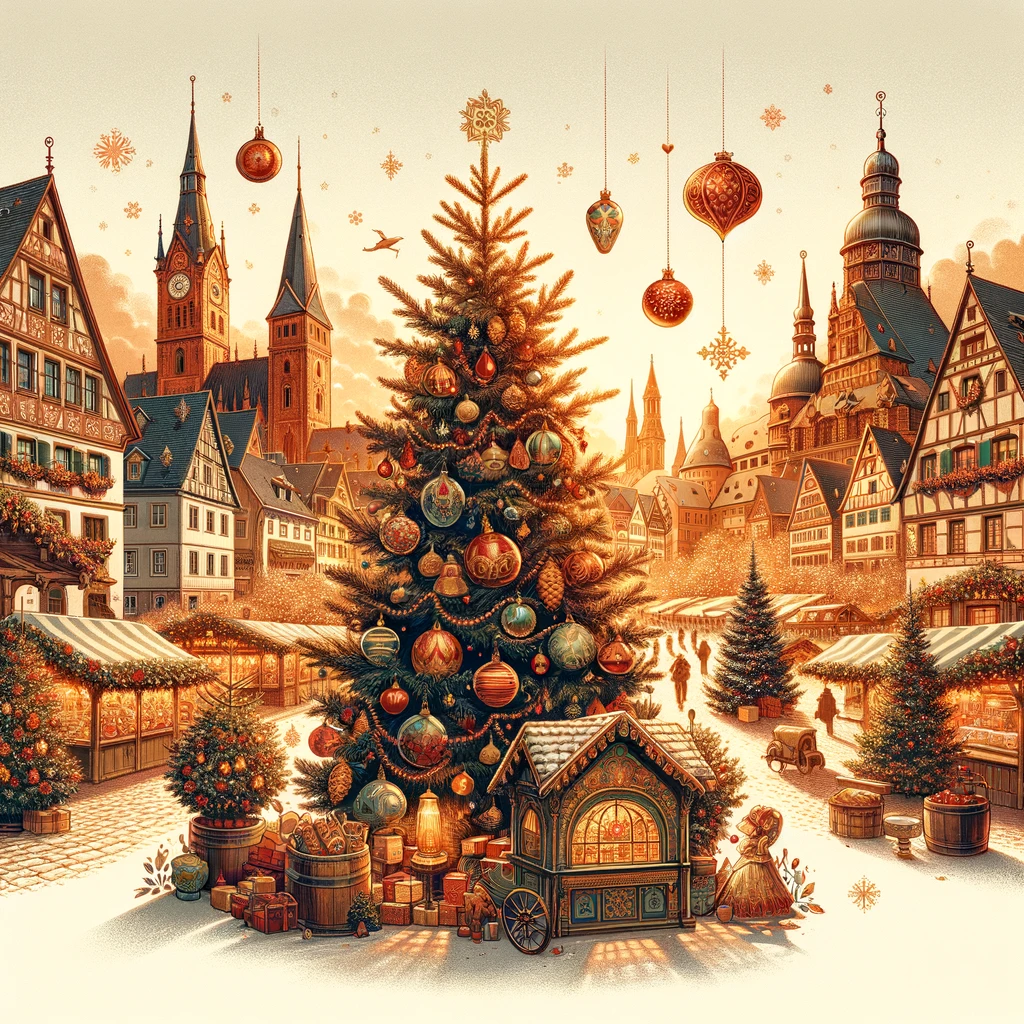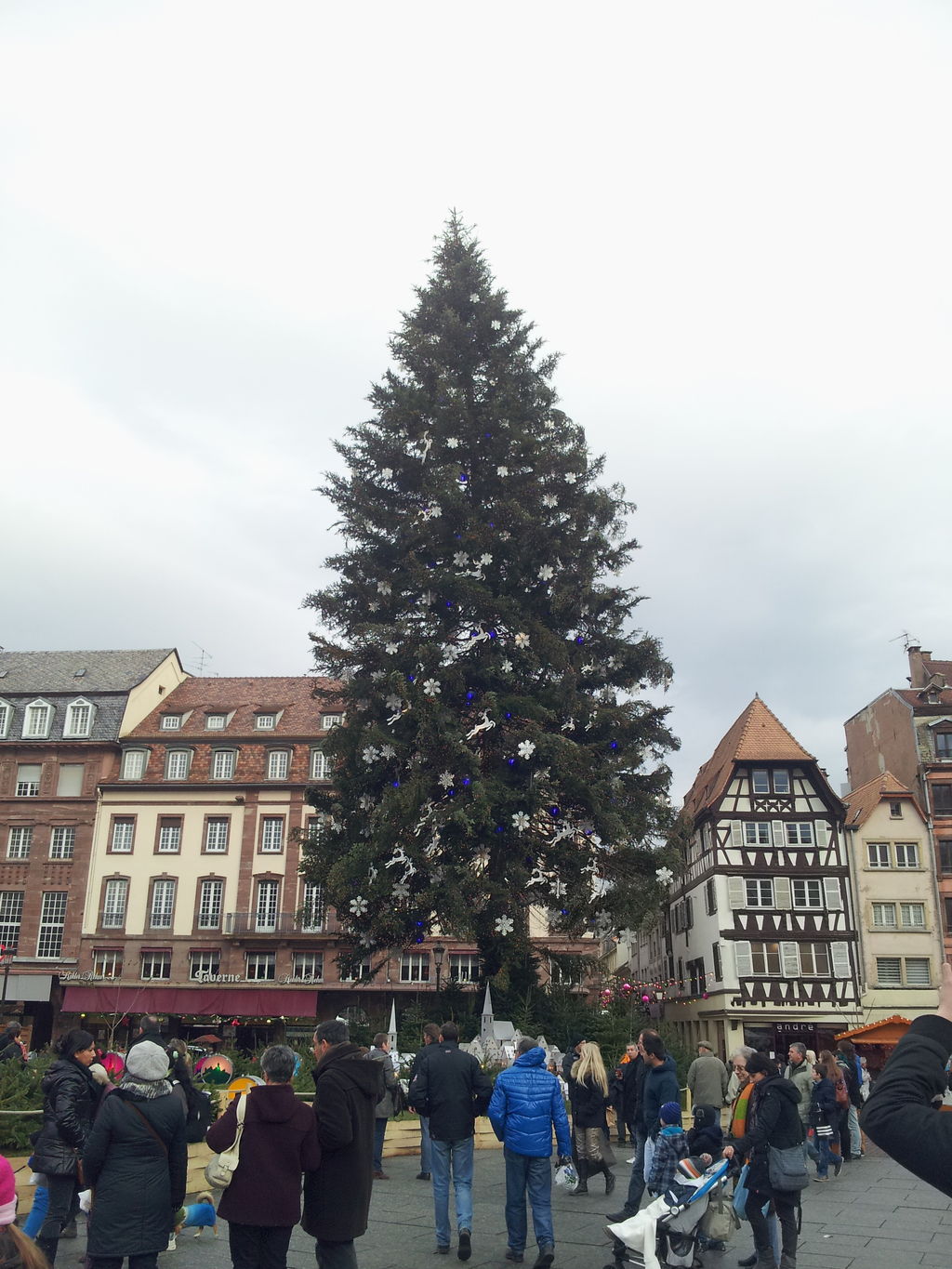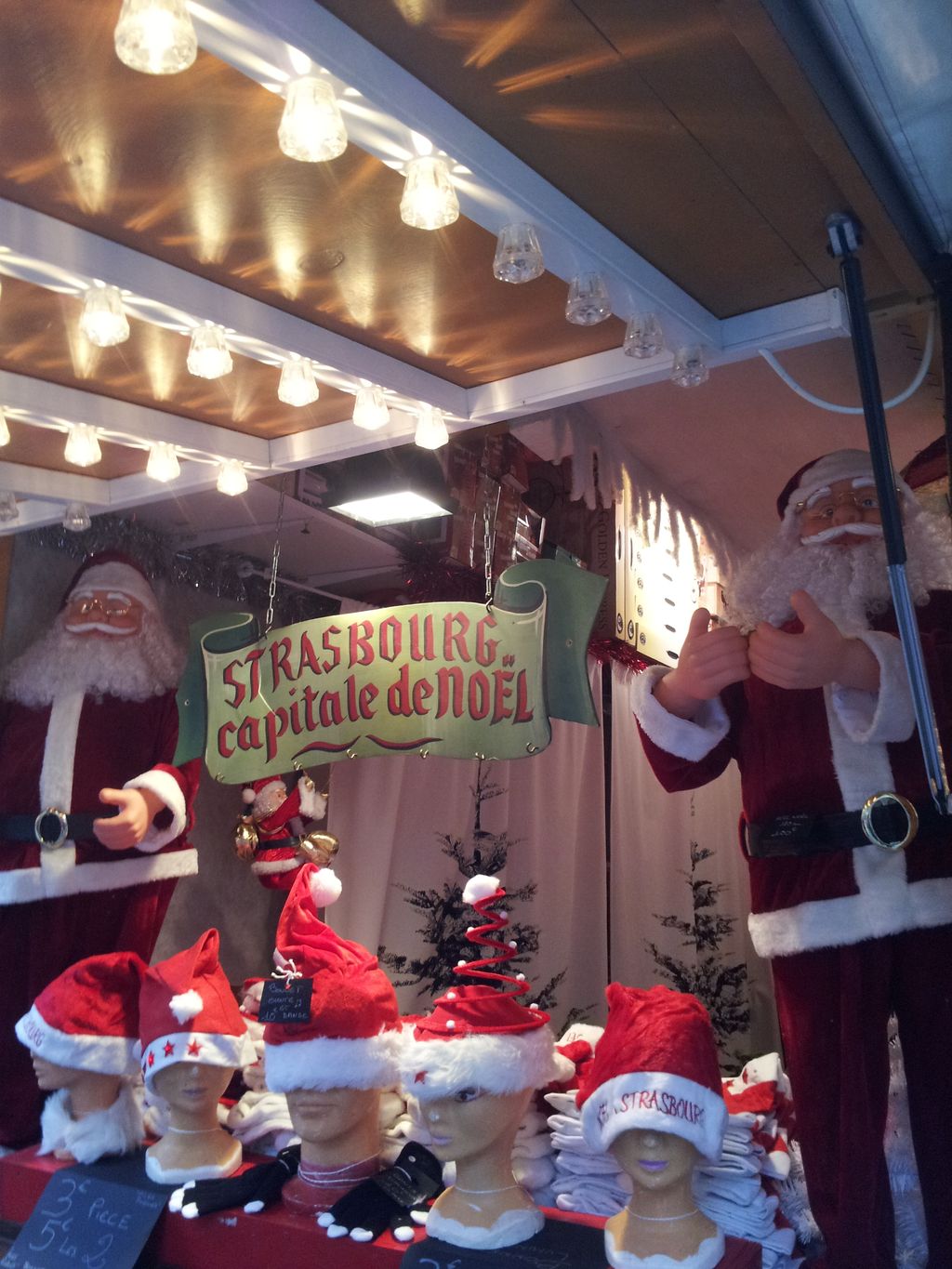Unwrapping the Past: A Deep Dive into the Origins and Evolving Traditions of Christmas
- The Origins of Christmas
- Pagan Influences and the Winter Solstice
- The Christian Adoption of December 25th
- Early Christian Celebrations
- The Evolution of Christmas Celebrations: The Pivotal Role of the Elsass Region
- Christmas Trees: The Strasbourg Tradition
- Glass Tree Ornaments: A Sparkling Innovation from the Vosges
- Christmas Markets: The Joyful Gathering in Strasbourg
- The First Documented Christmas Trees: The Strasbourg Tradition of 1492
- Christmas Markets - A Centuries-Old Tradition
- The Birth of the Christmas Tree Glass Ball: A Sparkling Innovation from Goetzenbruck in 1858
- Varied and Vibrant Christmas Traditions Around the World
- The Commercialization of Christmas
- Conclusion
- Frequently Asked Questions
Discover the rich tapestry of Christmas, a festival that transcends boundaries and unites millions in celebration. In this article, we delve into the fascinating origins of Christmas, tracing its journey from pagan roots to a global phenomenon. Join us as we explore the historical milestones and unique traditions that shape this beloved holiday.
The Origins of Christmas
Christmas, celebrated globally on December 25th, is a festival rich in history and symbolism. While widely recognized as the day marking the birth of Jesus Christ in Christian tradition, the origins of Christmas festivities are more complex and intertwine with various cultural and pagan traditions.
Pagan Influences and the Winter Solstice
The date of December 25th aligns closely with the winter solstice, a time celebrated in various ancient cultures. The Romans, for instance, celebrated Saturnalia, a festival dedicated to Saturn, the god of agriculture. This festival, which began on December 17th and lasted for about a week, was marked by a period of merriment, feasting, and a reversal of conventional social roles.
Roma, Italy, where the temple of Saturne is locatedAdditionally, the Norse cultures celebrated Yule from late December through January. During this period, people would burn Yule logs, feast until the log burnt out, and believed that each spark from the fire represented a new pig or calf to be born in the new year. Other regions would also celebrate winter solstice in various ways.
The Christian Adoption of December 25th
The Bible does not specify the date of Jesus Christ's birth, and early Christians did not celebrate his birth as a significant event. The choice of December 25th was influenced by a desire to align with and eventually supplant existing pagan festivals.
This date was also significant in Roman culture as the birthday of Sol Invictus, the Unconquered Sun, a deity whose worship increased in popularity in the late Roman Empire.
Early Christian Celebrations
The earliest Christmas celebrations were more about the solemnity of Christ's birth rather than the festive, gift-giving event it has become. It wasn’t until the Middle Ages that Christmas started to gain prominence. The Feast of the Nativity spread throughout the Christian world by the end of the 8th century, and the 12 days of Christmas (from December 25th to January 6th) were established as a sacred and festive season.
The Evolution of Christmas Celebrations: The Pivotal Role of the Elsass Region
The evolution of Christmas celebrations, particularly the traditions we associate with the holiday today, can be significantly attributed to the cultural heritage of the Elsass region, now part of modern-day France and Germany. This area, with its rich history and unique customs, has been a central influence in shaping Christmas celebrations, especially regarding the Christmas tree, glass ornaments, and Christmas markets.
Christmas Trees: The Strasbourg Tradition
The tradition of the Christmas tree, now central to the holiday's celebration worldwide, has its roots in Strasbourg, a city in the Elsass region, dating back to 1492. The practice of bringing a decorated tree into the home during the Christmas season originated here. These early Christmas trees were adorned with fruits, nuts, and paper flowers, symbolizing life and renewal in the midst of winter's darkness. The Strasbourg tradition of the Christmas tree quickly spread throughout Germany and then to the rest of Europe and North America, becoming a quintessential symbol of the holiday season.
Glass Tree Ornaments: A Sparkling Innovation from the Vosges
The northern region of the Vosges, close to Elsass, is credited with another significant contribution to Christmas celebrations: the introduction of glass tree ornaments. In 1858, artisans in this region, known for their glass-making skills, began producing glass balls to decorate Christmas trees. These glass ornaments were a step away from the traditional decorations of fruits and nuts, offering a more durable and reflective option that beautifully caught the light of candles, which were commonly used to illuminate Christmas trees at the time. The glass ball ornaments from the Vosges region symbolize the fusion of traditional practices with new, innovative ideas, enhancing the festive spirit of the holiday.
Christmas Markets: The Joyful Gathering in Strasbourg
The Christmas market, another cornerstone of holiday festivities, also has its origins in the Elsass region. The first known Christmas market was held in Strasbourg in 1570. Known as Christkindelsmärik (market of the Infant Jesus), it was a place where people gathered to buy seasonal food, sweets, and crafts in preparation for the Christmas festivities. The Strasbourg Christmas market set a precedent for other European cities, leading to the widespread popularity of Christmas markets. These markets, with their festive atmosphere, local crafts, and culinary delights, encapsulate the spirit of community and celebration that is now synonymous with the Christmas season.
The First Documented Christmas Trees: The Strasbourg Tradition of 1492
The tradition of the Christmas tree, now a ubiquitous symbol of the holiday season, has its historical roots in the medieval city of Strasbourg, located in the Elsass region. The first documented evidence of Christmas trees dates back to Strasbourg in the year 1492, marking a pivotal moment in the history of Christmas celebrations.
In 1492, the residents of Strasbourg, then part of the Holy Roman Empire, brought fir trees into their homes during the Christmas season. These trees were not just simple decorations but held significant symbolic value. They were seen as a symbol of life and hope in the midst of winter's darkness, representing the enduring life force even in the coldest and bleakest of times.
The earliest Christmas trees were adorned with simple, natural decorations. Families decorated their trees with colored paper, fruits, nuts, and sweets. This not only added a festive charm to the tree but also reflected the season's bounty and joy. The tradition was deeply rooted in family and community practices, with each household adding its personal touch to the tree decorations.
The Christmas tree tradition in Strasbourg quickly gained popularity and began to spread beyond the city's boundaries. By the 16th century, it had become a common practice in many parts of Germany. The appeal of the Christmas tree was in its simplicity and the joy it brought to homes during the holiday season. By the 19th century, this tradition had spread across Europe and eventually reached North America, where it was embraced and became an integral part of Christmas celebrations.
The Strasbourg Christmas tree tradition of 1492 stands as a testament to the city's cultural influence on the wider Christmas festivities. It marked the beginning of a practice that would become central to the holiday's celebration globally. The Christmas tree, originating from this medieval city, has now become a universal symbol of the season, transcending cultural and national boundaries.
Christmas Markets - A Centuries-Old Tradition
The tradition of Christmas markets, with their blend of festive cheer, culinary delights, and artisan crafts, is an integral part of the holiday season. The roots of this tradition can be traced back to the world's oldest Christmas market, which originated in the historic city of Strasbourg, a gem in the Elsass region.
World's oldest Christmas market, from Strasbourg, known as Christkindelsmärik, dates back to 1570 as we know today, and might exist since 12th Century in other forms. This market, set against the backdrop of the majestic Strasbourg Cathedral, is considered the oldest in the world. It started as a one-day event where local craftsmen, bakers, and farmers sold their wares and produce to the townsfolk, who were preparing for the holiday festivities.
From its humble beginnings, the Strasbourg Christmas market quickly grew in size and reputation. The market's atmosphere is a lively blend of festive music, twinkling lights, and the aroma of seasonal treats. Stalls at the market offer a variety of goods, from handcrafted ornaments and gifts to traditional Alsatian Christmas delicacies like bredele biscuits, vin chaud (mulled wine), and pain d'épices (gingerbread).
The Christkindelsmärik has not only been a place for commerce but also a cultural gathering point, fostering a sense of community and celebration. Over the centuries, this market has evolved, becoming a symbol of the festive spirit and a key part of Strasbourg's cultural heritage. It has inspired the creation of Christmas markets in other cities across Europe and around the world, each adding its unique local flavor.
Today, Strasbourg proudly bears the title Capital of Christmas. The market spans several city squares, offering an enchanting experience that attracts visitors from around the globe. The Christkindelsmärik has become more than just a market; it's an embodiment of the joy and warmth of the Christmas season, reflecting centuries of traditions and communal celebrations.
The Birth of the Christmas Tree Glass Ball: A Sparkling Innovation from Goetzenbruck in 1858
The invention of the Christmas tree glass ball ornament, a now-iconic decoration, has its roots in a small yet significant historical event in 1858. This year marked a turning point in the traditional decoration of Christmas trees, thanks to an ingenious solution by a glassblower from Goetzenbruck, a village renowned for its glass-making in the northern Vosges region near Elsass.
In 1858, a severe drought hit the region, drastically reducing the availability of fruits traditionally used to decorate Christmas trees. This scarcity posed a challenge for the festive season, as fruits, nuts, and sweets were the primary decorations for Christmas trees, symbolizing abundance and the bounty of nature.
Facing the scarcity of fruits, a skilled glassblower from Goetzenbruck, drawing upon the region's rich glass-making heritage, came up with a novel solution. He crafted glass balls to replace the fruits that were traditionally hung on Christmas trees. These Christmas tree glass balls invented in 1858 by a glassblower in Goetzenbruck, Elsass, France, or baubles, were designed to mimic the shape and appearance of fruits but with the added brilliance and shine of glass.
The new glass ball ornaments quickly gained popularity. Their reflective surface, sparkling in the light of candles and later, electric lights, added a new dimension of beauty to the Christmas tree. The glass balls were not only aesthetically pleasing but also more durable than their natural counterparts. This innovation marked a departure from the traditional decorations and paved the way for a new era of Christmas tree adornment.
The idea of glass ball ornaments spread rapidly from Goetzenbruck across Europe and eventually to other parts of the world. It resonated with the festive spirit of the times, integrating the old-world charm of glass craftsmanship with the evolving traditions of Christmas. By the late 19th and early 20th centuries, glass ball ornaments had become a staple of Christmas tree decorations, a status they maintain to this day.
Varied and Vibrant Christmas Traditions Around the World
Christmas is celebrated in myriad ways around the globe. In Japan, a modern tradition involves eating KFC on Christmas Eve, while in Italy, children await gifts from La Befana, a kind witch, rather than Santa Claus. These diverse traditions reflect the universal joy and spirit of the season.
The Commercialization of Christmas
In the modern era, Christmas has also become a significant commercial event. This commercialization has influenced how the holiday is celebrated, with a greater emphasis on gift-giving and festive marketing. While this shift has sparked debate, the core values of joy, generosity, and family remain at the heart of Christmas.
Conclusion
As we draw the curtains on our exploration of Christmas and its myriad traditions, one striking revelation stands out: the remarkable influence of the Elsass region in shaping how we celebrate this festive season. Nestled between France and Germany, this culturally rich area has been a veritable crucible for many customs that now define Christmas across the globe.
From the twinkling lights of the Christmas tree originating in Strasbourg in 1492 to the sparkling glass baubles innovated by a Goetzenbruck craftsman in 1858, Elsass has gifted the world some of its most cherished Christmas symbols. These traditions, born out of a blend of historical circumstances, creativity, and cultural exchange, have transcended their regional origins to become integral to global Christmas festivities.
The Christkindelsmärik of Strasbourg, established in 1570, not only stands as the oldest Christmas market but also as a template for the festive markets that now light up cities worldwide during the holiday season. These markets, with their enchanting blend of community spirit, seasonal treats, and artisanal crafts, capture the essence of the traditional Christmas spirit – a spirit of togetherness, joy, and warmth.
The story of Christmas, as told through the lens of the Elsass region, is one of enduring traditions evolving through time while retaining their core essence. It is a story that underscores the region's unique position at the crossroads of European cultures, a position that has enabled it to be a beacon of festive innovation and joy.
As we celebrate Christmas each year, amidst the glow of tree lights, the clinking of glass ornaments, and the festive bustle of markets, we partake in traditions that have their roots deep in the heart of Elsass. These traditions, having stood the test of time, continue to bring people together, embodying the timeless spirit of the holiday season and reminding us of the enduring power of cultural heritage in shaping our most cherished celebrations.
Frequently Asked Questions
- What are the historical origins of Christmas, and how have the traditions associated with this holiday evolved over time?
- The origins of Christmas are rooted in ancient winter solstice festivals and the Christian celebration of the birth of Jesus. Traditions have evolved from religious ceremonies to include various cultural practices like gift-giving, tree decorating, and Santa Claus folklore.

Michel Pinson is a Travel enthusiast and Content Creator. Merging passion for education and exploration, he iscommitted to sharing knowledge and inspiring others through captivating educational content. Bringing the world closer together by empowering individuals with global expertise and a sense of wanderlust.





